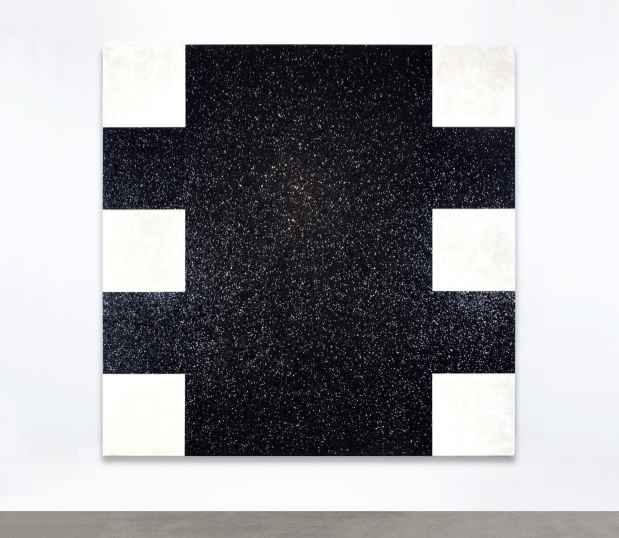Mary Corse Exhibition
Lehmann Maupin (536 W 22nd Street)

This event has ended.
Lehmann Maupin presents an exhibition of recent and significant historic work by Mary Corse. The Los Angeles-based artist’s third solo exhibition with the gallery is influenced by her Black Light Painting from 1975. Corse returns to the materials introduced in this earlier series with a prodigious 19-foot painting, Untitled (DNA Series) (2017) and an additional 10 new corresponding paintings to form a continued examination of the technical and theoretical framework she has honed over the past 50 years. These bold black-and-white works highlight Corse’s proficiency for varied surface treatments, including matte paint, gestural brushstrokes, and light-reflecting particles. These works encapsulate Corse’s longstanding investigation into the interaction between black and white and how it lends insight into the mechanizations of experience and perception.
Corse is recognized as a notable member of the 1960s Light and Space Movement of Southern California-based artists whose work is unified by their investigation into the circumstances of perception. Though Corse often worked on the periphery of her male counterparts, her deep exploration of the physical experience of seeing, and later the implications of perception in a metaphysical sense, have aligned her with artists such as Robert Irwin, James Turrell, and Douglas Wheeler. What makes Corse’s work unique among her Light and Space peers is her painterly approach and embrace of visible brushwork, as well as her strict adherence to paint as a medium. While others turned to architectural pursuits to achieve immersive installations and environments, Corse has remained committed to phenomenological pursuits via unique combinations of paint, reflective material, and the canvas, which she considers an abstracted dimensional field.
Primary to Corse’s practice is her understanding of sight as a subjective experience. This theory manifested in her work during the late 1960s with her use of white acrylic paint layered with microspheres, the tiny glass beads used to illuminate road dividers on a highway. Corse discovered the aesthetic and experiential possibilities of the material after testing various electrical devices to embed lighting within her painting. The painting is thus activated once a person stands in front of it, where differences in light conditions or movement around the canvas create variance within the piece. Together, the combination of materials and colors presents an opportunity for the viewer to confront an externalized reproduction of the act of seeing, where the representation of vision is manifest through Corse’s manipulation of light and color.
Black first entered Corse’s work during the 1970s. Corse found that incorporating light-reflecting, tiny acrylic squares within the all-black palette, often classified by the absence of light, achieved luminescence. The resulting pictorial plane, though rendered minimally, gives the illusion of deep space. The combination of alternating black-and-white bands and grids results in further optical illusion, where the borders between the colors appear to shift or glow. Furthering the potential of these pairings, her new series of smaller Untitled (DNA Series) paintings are grouped in twos as inverse couplings that make up representative segments of the larger painting from which they derive. This installation thus offers both macro and micro perspectives of optical phenomena, which Corse relates to the so-called uncertainty principle, the basis of quantum mechanics that is an area of personal study for the artist. The principle states that the exact location and velocity of any particle in space is unknowable, as a measurement of either affects the outcome of the other, an apropos metaphor for Corse’s exploration of objective reality as altered by subjective awareness.
Mary Corse (b. 1945, Berkeley, CA; lives and works in Los Angeles) received her BFA from the University of California in 1963, and her MFA from the Chouinard Art Institute in 1968. Select group exhibitions featuring her work include Light and Space, Seattle Art Museum, Seattle, (2015); Reductive Minimalism: Women Artists in Dialogue, 1960–2012, University of Michigan Museum of Art, Ann Arbor (2014); Venice in Venice, a collateral exhibition curated by Nyehaus in association with the J. Paul Getty Museum at the 54th Venice Biennale (2011); Pacific Standard Time: Crosscurrents in L.A. Painting and Sculpture, 1950-1970, J. Paul Getty Museum, Los Angeles (2011); What’s New, Pussycat?, Torrance Art Museum, Torrance, CA (2011); and Phenomenal: California Light and Space, Museum of Contemporary Art San Diego (2011). Corse’s work is in numerous international public and private collections, including the Blanton Museum of Art, The University of Texas at Austin; Fondation Beyeler, Basel, Switzerland; Frederick R. Weisman Art Foundation Collection, Los Angeles; the J. Paul Getty Museum, Los Angeles; Los Angeles County Museum of Art; Menil Collection, Houston; Museum of Contemporary Art, Los Angeles; Museum of Contemporary Art, San Diego; Norton Museum of Art, West Palm Beach, FL; Orange County Museum of Art at Newport Beach, CA; Seattle Art Museum; Solomon R. Guggenheim Museum, New York; and Whitney Museum of American Art, New York.
In 2016, Corse was commissioned by the U.S. General Services Administration to create a work for the new Los Angeles federal courthouse building. Corse is the recipient of the Cartier Foundation Award (1993); the National Endowment for the Arts Fellowship (1975); the Theodoran Award, Solomon R. Guggenheim Museum (1971); and the New Talent Award, Los Angeles County Museum of Art (1967).
Media
Schedule
from September 07, 2017 to October 07, 2017
Opening Reception on 2017-09-07 from 18:00 to 20:00